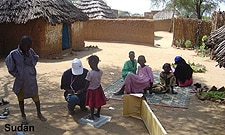Food and Nutrition in Complex Emergencies
Course Overview
This two credit course is held in the fall of each year and is offered as a collaboration between the Rollins School of Public Health and CDC.
The World Food Programme (WFP) distributes millions of metric tons of food each year to emergency-affected populations for whom this is their only food supply. Nonetheless, malnutrition during humanitarian emergencies, including protein-energy malnutrition and micronutrient deficiencies, are very common.
How do WFP and various non-governmental organizations decide when to distribute food, what type of food to distribute, and how much food to distribute? How do organizations concerned with nutrition evaluate nutritional status? What types of feeding programs are implemented in emergency situations? Some potential answers to these questions will be provided by this course.

Course Goal
To acquaint students with the principle nutrition problems in complex emergencies and to outline the major food and nutrition relief programs which attempt to deal with these problems in refugee and displaced populations.
Overall Objective
To equip public health professionals with technical and management skills necessary to take a lead role in planning, implementing, and evaluating appropriate nutrition programs for acutely displaced populations in developing countries.
Specific Objectives
At the end of the course, students should be able to:
- Describe the different types of macro- and micronutrient malnutrition common in emergency-affected, food-dependent populations.
- Describe the common programs found in humanitarian emergencies which address macronutrient and micronutrient malnutrition.
- Design an assessment of nutritional status to be carried out in a displaced population.
- Evaluate any general ration distributed to an emergency-affected, food-dependent population.
- Describe and evaluate the various methods of distributing food to populations.
More Information
If you are interested in applying, please e-mail: IERHB@cdc.gov.
Syllabus from previous year [PDF - 20 KB]
More information on Emory University
Contact Us:
- Centers for Disease Control and Prevention
1600 Clifton Rd
Atlanta, GA 30333 - 800-CDC-INFO
(800-232-4636)
TTY: (888) 232-6348
24 Hours/Every Day - CDC General Information: cdcinfo@cdc.gov
- International Emergencies & Refugee Health Branch Information: ierhb@cdc.gov


